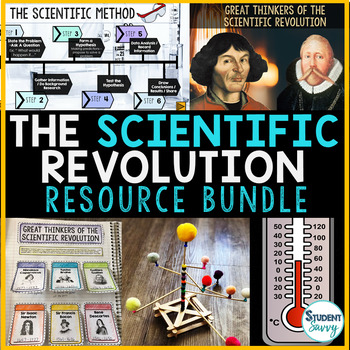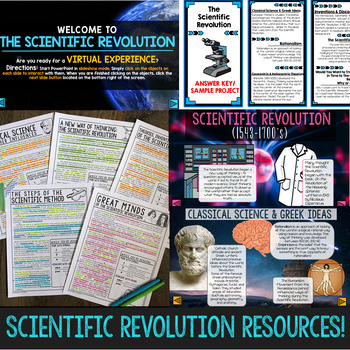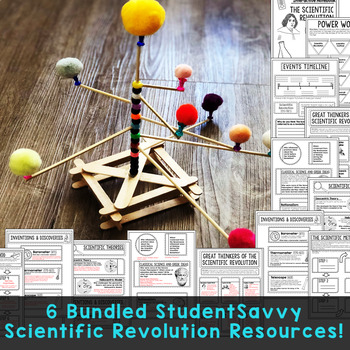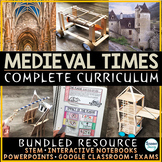The Scientific Revolution Activities Bundle Worksheets Reading Passages STEM
- Zip
- Google Apps™

What educators are saying
Products in this Bundle (6)
showing 1-5 of 6 products
Also included in
- Enhance your Middle Ages curriculum with our Medieval Times and Early Modern Times Complete Curriculum Bundle, available in digital Google Classroom and PDF print formats. With over 1500 pages/slide of material, this comprehensive resource covers Early Byzantine, Early Islam, West Africa, MedievalPrice $190.00Original Price $314.93Save $124.93
Description
The Scientific Revolution Activities Resource Bundle!
This bundled product contains the following 6 Scientific Revolution StudentSavvy resources:
Google Classroom Student Projects
_________________________________________________________________ More information on each resource:
-Interactive Notebook
This product contains interactive cut and paste learning material for students to create an organized social studies interactive notebook. Answer Key Included!
Topics covered in this unit include: Scientific Revolution, The Scientific Method, Nicolaus Copernicus, Tycho Brahe, Galileo Galilei, Sir Isaac Newton, Sir Francis Bacon, René Descartes, Rationalism, Greek Ideas and Classical Science, Scientific Theories, Geocentric Theory, Heliocentric Model, Inventions and Discoveries, Invention of the Microscope, Invention of the Barometer, Thermometer, Invention of the Telescope, and more!
_________________________________________________________________ -Reading Passages
Questions & Answer Keys for Each of the 5 Reading Passages! COMMON CORE ALIGNED! Quick overview of topics covered in this resource include:
1.) A New Way of Thinking: The Scientific Revolution
-“On the Revolution of the Heavenly Spheres” book by Nicolaus Copernicus changed the way people thought of the world – realized that Earth was not the center of the universe. His book may have began the Scientific Revolution.
-Overview of key ideas that came about from the Scientific Revolution (The realization that science is important, beneficial to society, and exciting. Earth revolves around the Sun, The Scientific Method, Laws of Motion, etc. )
-Classical science and the Humanist movement paves the way for Scientific Revolution
Keywords: Scientific Revolution, theory, Humanism
2.) The Great Minds of the Scientific Revolution
-Overviews of the following great thinkers:
Nicolaus Copernicus (and the heliocentric model)
Tycho Brahe (astronomer who studied the night sky and planets, observed the Super Nova of 1572)
Galileo Galilei (improvements to the telescope, theory of inertia)
Sir Isaac Newton (Newton’s Law of Motion, reflecting telescope, color - objects reflecting light)
Sir Francis Bacon (using proper scientific method – supporting theories with proof, observation, and experimentation)
Rene Descartes (“I think, therefore I am” great philosopher, made connections between geometry and algebra)
Keywords: universal gravitation, inertia, heliocentric model, geocentric theory
3.) Classical Science and Other Influences
-Preserved ideas from the Ancient Greeks influenced the ideas that came from the Scientific Revolution
-Overview of famous Greek Philosophers that came from this time period – Aristotle, Euclid, Galen, etc.
-Overview of Rationalism (another influence of the Scientific Revolution) – viewing the world in a logical, rational way. Rationalist philosophers include Rene Descartes, Baruch Spinoza, and Gottfried Wilhelm Leibniz
Keywords: Rationalism
4.) Theories, Inventions, and Discoveries of the Scientific Revolution
-Introduction to how the Scientific Revolution was a time for invention and discovery (a new way of thinking)
-Overview of Geocentric Theory and Heliocentric Model
-Overview of inventions - the microscope, barometer, thermometer, telescope (how Galileo improved the design)
Keywords: Geocentric theory, Heliocentric model, barometer,
5.) The Steps of the Scientific Method
-Overview of what the scientific method is (step-by-step set of procedures, gold standard for investigating the natural world)
-Provides each of the six steps in detail
Keyword: The Scientific Method, hypothesis
________________________________________________________________
Interactive PowerPoint
This teaching resource is quite the virtual experience! This Medieval Times / Ancient Civilizations PowerPoint can be used as a powerful classroom presentation or students can click their way through it on individual computers.
Topics covered in this unit include: Scientific Revolution, The Scientific Method, Nicolaus Copernicus, Tycho Brahe, Galileo Galilei, Sir Isaac Newton, Sir Francis Bacon, René Descartes, Rationalism, Greek Ideas and Classical Science, Scientific Theories, Geocentric Theory, Heliocentric Model, Inventions and Discoveries, Invention of the Microscope, Invention of the Barometer, Thermometer, Invention of the Telescope, and more!
_________________________________________________________________ -STEM Challenges
Cross-curricular challenges for students who are studying Ancient Civilizations, Middle Ages, and/or Medieval Times!
There are 2 Scientific Revolution STEM Challenges in this pack. Each STEM Challenge has detailed directions, photo examples, a list of materials needed, prediction section, brainstorming section, trials 1, 2, & 3, final results section with drawings, and a reflection section.
The STEM Challenges include:
1. Heliocentric Model
Using a list of supplies, students must design and build a 3-D heliocentric model. The planets (Mercury, Venus, Earth, Mars, Jupiter, Saturn, Uranus, and Neptune) in the model must effectively move and orbit the sun, without bumping into each other. If they test it and it does not work properly, they have two more attempts to fix their design...(more instructions and planning pages are given in the resource)
2. Barometer Challenge
Using a list of supplies, students must design a type of barometer that measures changes in the atmospheric pressure. Their design must have a needle that measures an increase or decrease in air pressure. Students must use the items listed below and they are not allowed to add items to the list. If they test it and it does not work properly, they have two more attempts to fix their design.... (more instructions and planning pages are given in the resource)
_________________________________________________________________ -Google Classroom Student Projects
3 digital projects for your students!
This product contains 3 digital projects that students can complete using Google Slides! This resource has a brochure project, a timeline project, and a info-graphic / poster project.
Each student-centered project has a sample project, answer key, and detailed project instructions for the students.
Info-graphic / Poster Project
Students pick a topic that they would like to research on The Scientific Revolution (Ex: Nicolaus Copernicus, Rationalism, The Geocentric Theory, and Heliocentric Model, Invention of the Telescope, etc.) All of the elements in the info-graphic must be organized, clearly visible, and well placed. Creativity with color and photos is a must! **More instructions found in the resource
Timeline Project
Using a template, students design a timeline of important events during the Scientific Revolution. Students can add images, text, and other media to their timelines.
It is up to the teacher to add or change time periods that align with school resources.
Brochure Project
Using a template, students design a brochure that highlights important facts and topics of The Scientific Revolution such as: Classical Science & Greek Ideas, Rationalism, The Scientific Method, Inventions and Discoveries, etc.
_________________________________________________________________
-Exam - Test - Assessment
This resource contains an assessment that has vocabulary matching, fill in the blank, short answer, essay, and an info-graphic. It has 18 questions total.
It also contains an ANSWER KEY and an EDITABLE PowerPoint file.
Tips for Savvy TpT Shoppers:
How to receive credit on TpT to use for future purchases:
• Go to your My Purchases page. Under each purchase you'll see a Provide Feedback button. Simply click it and you will be taken to a page where you can give a quick rating and leave a short comment for the product. I value your feedback greatly as it helps me determine which products are most valuable for your classroom so I can create more for you.
Be the first to know about my new discounts, FREEBIES, and products:
• Look for a green star near the top of any page within my store and click it to become a follower. You will now be able to see FREEBIES and customized emails from my store!
©2019 StudentSavvy All rights reserved by author. Permission to copy for single classroom use only. Electronic distribution limited to single classroom use only. (unless you purchase the multiple license)






